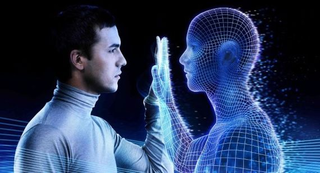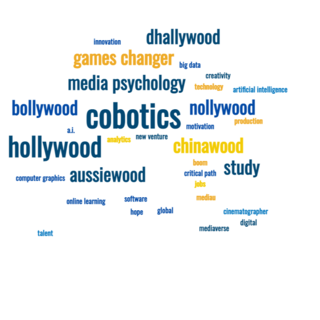Cobotics (combining artificial intelligence and human effort) is increasingly central to the work of media industry professionals. The expansion of cobotics was dramatically stimulated in early 2020 by sudden universal requirements for social-distancing and increased work-from-home, in efforts to slow the spread of the COVID-19 pandemic.
ZOOM, as one example of a cobotic tool, has boomed and grown from 30 million to more than 300 million users since the pandemic began. During 2020, millions of employees transitioned to working in fully remote ways for the first time. This triggered new, immediate, and innovative developments in media production, media-streaming services, new entertainment, and remote-education offerings. Many home entertainment viewing habits have changed. For example, frequent theater-going has been significantly replaced by streaming-enabled binge-watching.
All manner of services and products have exploded:
Power skills—skills such as creativity, collaboration, critical thinking, emotional intelligence, and innovation—combine with “hard,” practical skills to create an occupational tsunami of change in how media-centric tasks are accomplished. Forward-thinking leaders are continually reimagining entertainment industry services. Organizations are accelerating the hunt for workers with unique, advanced combinations of talents.
Populated by many new applications (Zakaria, 2020), the combination of new AI strategies with human talent and creativity known as cobotics is growing. New aspirants and experienced professionals are upskilling their knowledge in ways that fit the emerging media industry markets. With theaters and entertainment venues currently closed or limited and streaming services booming, pre-pandemic entertainment product distribution and consumer access methods are rapidly changing and adapting, reflecting new worldwide behaviors.
Health guidelines to stay at home have created an entertainment boom for Netflix, Spotify, YouTube, Apple Plus, and many other entertainment streaming services. On Christmas day, I streamed HBO Plus’s Wonder Woman 1984 into my home while it was simultaneously released in theaters. Simultaneous theater/home release is one example of a significant and permanent change triggered by the pandemic.
Modern media professionals are adapting:

Human & Artificial IntelligenceSource: LuskinInternational, with permission
Examples of change can be seen in the work of industry professionals such as production accountants, animation technicians, casting professionals, cinematographers, directors of film, television and media products, data analysts, documentary producers, writers, editors, human resource specialists, instructional designers, interactive media specialists, learning content managers, lighting, camera, and CGI arts professionals; makeup artists and hairstylists, social media staffers, music production specialists, artists, performers, producers, production executives, production managers, professional representatives, talent managers and agents, public relations specialists, robotics technicians, on-set safety and sanitation specialists, social media big data analysts, looping and dubbing professionals, sound editors and technicians, special visual effects specialists, stunt performers, and more.article continues after advertisement
Insights into the new work-related realities. I interviewed a diverse cross-section of accomplished C-level executive and talent-management experts. Three of the distinguished professionals interviewed in-depth regarding professional changes are:
- Dr. Robert (Bob) Wright, CEO of Wright Graduate University and a global visionary in transformational leadership and coaching. Wright said that “Human-centered transformation requires a passionate, motivated, adaptive and open-minded acceptance of change, including a “yearning for learning.”
- Adam Leipzig , CEO of MediaU, an innovative media education and training company providing programs that help individuals assimilate advances in media industry work. Leipzig says, “There is an immediate industry demand for credible, shorter, certificate and badge programs that upskill and validate the currency of industry professionals. This refined, streamlined approach to upskilling through high-quality learning experiences with practical applications requires a willingness to adapt.”
- William (Bill) Simon , a leading entertainment industry executive-search professional at Korn-Ferry International specializing in the placement of C-suite executives in the media industry, said, “Taking over common tasks has been a feature of AI for a long time. Much of AI is targeted toward practical skills in media jobs. The new cobotics professionals understand how to combine highly-developed human skills and motivation, with advancing technology. The coronavirus pandemic spotlights the need for ‘talent’ as worldwide media industries change and adapt.”
My objective is to research, validate, and share a series of articles that explore promising new opportunities arising from the changes taking place in the entertainment industry and report the new ways of dealing with them.
The global scope of the media industry:

Jobs in the New WorldSource
Hollywood has now linked people, products, and services worldwide by integrating product from Dhallywood (Bangladeshi media industry), Bollywood (India), Lollywood (Pakistan), Swahiliwood (Tanzania), Aussiewood (Australia), Nollywood (Nigeria), and Chinawood (China), examples of the many new film, television, streaming-media and new product arenas emerging as worldwide hotspots. Eric Doctorow, CEO at movie distribution leader Random Media, told me that he is now distributing films of all types to countries all over the globe.article continues after advertisement
Satellite and internet streaming services now span language and cultural borders. We are experiencing a new world of binge-watching, subtitles, looping, dubbing, and captioning as film, television, games, and other media accommodate a globalized audience. The trend is that there will be an increasing number of jobs worldwide working in the new “woods.”
Media industry work in the future will be quite different: As the way work is done changes, it is more important than ever to match the skills and talent needed to do that work optimally. More sophisticated technology platforms are rapidly evolving and demand that professionals stay current. In the months and years ahead, we will continue to overcome systemic barriers, altering media products to fit various cultures. We will develop and offer new types of workforce credentials to validate a professional’s ability to meet the evolving demands of the media industry’s requirements.
The knowledge curve: Buckminster Fuller, in his book Critical Path (1982), articulated the “knowledge-doubling curve.” New knowledge, he pointed out, had doubled every century until 1900. By post-WWII, it was doubling every 25 years (Fuller, 1982). That pace of growth has continued, and some assert it is increasing exponentially. In an article published in IndustryTap, David Schilling argues that the internet is doubling knowledge every 13 months, and with the help of the internet, we will soon double human knowledge every 12 hours (Schilling, 2013). Whatever the actuality, information is increasing at an extraordinary rate.
Dr. Krishna Kumar, 2020 president of the Society for Media Psychology and Technology of the American Psychological Association, told me that, “Studying AI as an important subspecialty applied to how people work has become an APA priority.”
All with whom I spoke agreed that fostering the transformation of human skills represents a systemic bridge affecting worldwide products and services. Up-to-date talent, able to work cross-culturally and remotely in new ways, is the key to continuing progress in today’s’ mediaverse.article continues after advertisement
Cobotics will be a media industry game-changer in our lifetime.
References:
- Fuller, R.B. (1982). Critical Path (2nd ed.). New York: St. Martin’s Griffin.
- Schilling, D.R. (2013). Knowledge Doubling Every 12 Months, Soon to Be Every 12 Hours. IndustryTap.com, (April 19, 2013). Retrieved from IndustryTap.com website:
- Merisotis, Jamie, (2020).Human Work in the Age of Smart Machines, (1st ed.). New York: Rosetta Books.
- Zakaria, F. (2020). Ten Lessons for a Post Pandemic World (1st ed.). New York: W.W. Norton & Company
Special thanks: Toni Luskin, Ph.D., for editorial and publishing assistance and to Christina Chironna and Aryeh Hoppenstein of Filmup.com, Lucia Cottone of KnackTalent.com, Eric Doctorow, CEO at Random Media, and Krishna Kumar, Ph.D., president of APA Division 46, for valuable insights into the changing nature of industry talent requirements and work in media.
This article was originally published here.








